weight LINCOLN NAUTILUS 2021 Owners Manual
[x] Cancel search | Manufacturer: LINCOLN, Model Year: 2021, Model line: NAUTILUS, Model: LINCOLN NAUTILUS 2021Pages: 579, PDF Size: 6.9 MB
Page 14 of 579
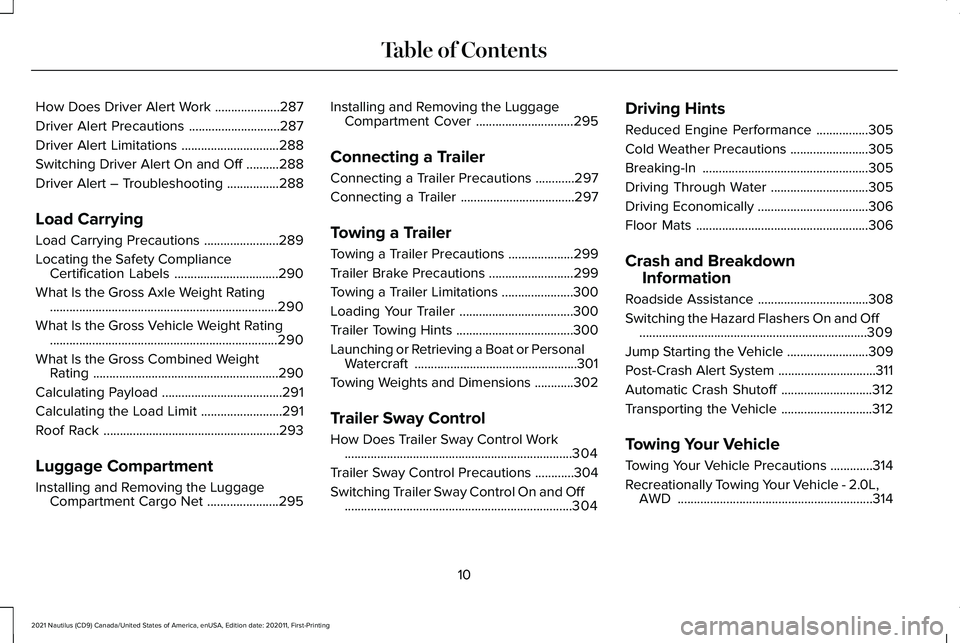
How Does Driver Alert Work
....................287
Driver Alert Precautions ............................
287
Driver Alert Limitations ..............................
288
Switching Driver Alert On and Off ..........
288
Driver Alert – Troubleshooting ................
288
Load Carrying
Load Carrying Precautions .......................
289
Locating the Safety Compliance Certification Labels ................................
290
What Is the Gross Axle Weight Rating ......................................................................
290
What Is the Gross Vehicle Weight Rating ......................................................................
290
What Is the Gross Combined Weight Rating .........................................................
290
Calculating Payload .....................................
291
Calculating the Load Limit .........................
291
Roof Rack ......................................................
293
Luggage Compartment
Installing and Removing the Luggage Compartment Cargo Net ......................
295Installing and Removing the Luggage
Compartment Cover ..............................
295
Connecting a Trailer
Connecting a Trailer Precautions ............
297
Connecting a Trailer ...................................
297
Towing a Trailer
Towing a Trailer Precautions ....................
299
Trailer Brake Precautions ..........................
299
Towing a Trailer Limitations ......................
300
Loading Your Trailer ...................................
300
Trailer Towing Hints ....................................
300
Launching or Retrieving a Boat or Personal Watercraft ..................................................
301
Towing Weights and Dimensions ............
302
Trailer Sway Control
How Does Trailer Sway Control Work ......................................................................
304
Trailer Sway Control Precautions ............
304
Switching Trailer Sway Control On and Off ......................................................................
304 Driving Hints
Reduced Engine Performance
................
305
Cold Weather Precautions ........................
305
Breaking-In ...................................................
305
Driving Through Water ..............................
305
Driving Economically ..................................
306
Floor Mats .....................................................
306
Crash and Breakdown Information
Roadside Assistance ..................................
308
Switching the Hazard Flashers On and Off ......................................................................
309
Jump Starting the Vehicle .........................
309
Post-Crash Alert System ..............................
311
Automatic Crash Shutoff ............................
312
Transporting the Vehicle ............................
312
Towing Your Vehicle
Towing Your Vehicle Precautions .............
314
Recreationally Towing Your Vehicle - 2.0L, AWD ............................................................
314
10
2021 Nautilus (CD9) Canada/United States of America, enUSA, Edition date: 202011, First-Printing Table of Contents
Page 43 of 579
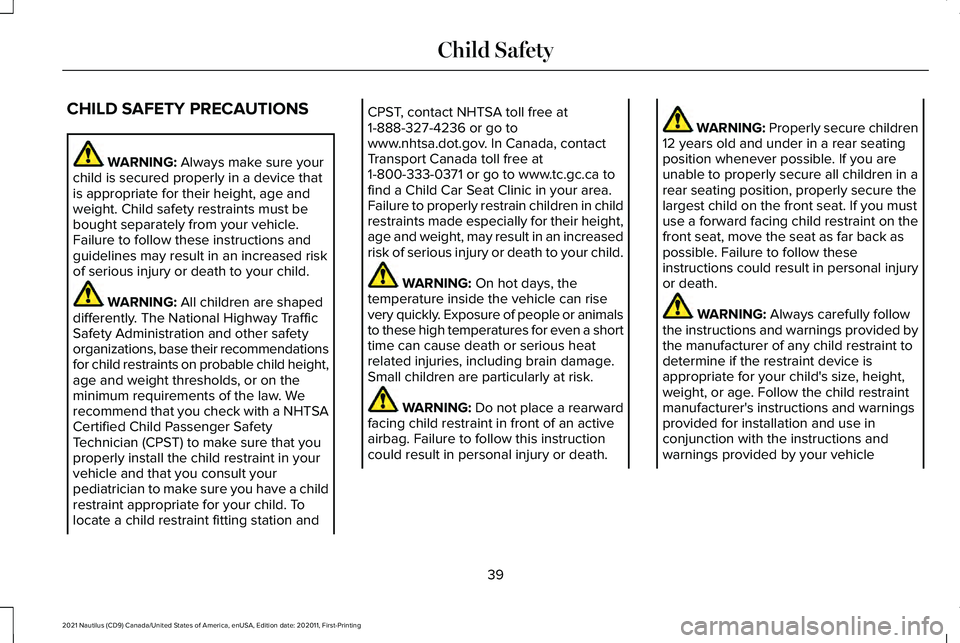
CHILD SAFETY PRECAUTIONS
WARNING: Always make sure your
child is secured properly in a device that
is appropriate for their height, age and
weight. Child safety restraints must be
bought separately from your vehicle.
Failure to follow these instructions and
guidelines may result in an increased risk
of serious injury or death to your child. WARNING:
All children are shaped
differently. The National Highway Traffic
Safety Administration and other safety
organizations, base their recommendations
for child restraints on probable child height,
age and weight thresholds, or on the
minimum requirements of the law. We
recommend that you check with a NHTSA
Certified Child Passenger Safety
Technician (CPST) to make sure that you
properly install the child restraint in your
vehicle and that you consult your
pediatrician to make sure you have a child
restraint appropriate for your child. To
locate a child restraint fitting station and CPST, contact NHTSA toll free at
1-888-327-4236 or go to
www.nhtsa.dot.gov. In Canada, contact
Transport Canada toll free at
1-800-333-0371 or go to www.tc.gc.ca to
find a Child Car Seat Clinic in your area.
Failure to properly restrain children in child
restraints made especially for their height,
age and weight, may result in an increased
risk of serious injury or death to your child.
WARNING:
On hot days, the
temperature inside the vehicle can rise
very quickly. Exposure of people or animals
to these high temperatures for even a short
time can cause death or serious heat
related injuries, including brain damage.
Small children are particularly at risk. WARNING:
Do not place a rearward
facing child restraint in front of an active
airbag. Failure to follow this instruction
could result in personal injury or death. WARNING:
Properly secure children
12 years old and under in a rear seating
position whenever possible. If you are
unable to properly secure all children in a
rear seating position, properly secure the
largest child on the front seat. If you must
use a forward facing child restraint on the
front seat, move the seat as far back as
possible. Failure to follow these
instructions could result in personal injury
or death. WARNING:
Always carefully follow
the instructions and warnings provided by
the manufacturer of any child restraint to
determine if the restraint device is
appropriate for your child's size, height,
weight, or age. Follow the child restraint
manufacturer's instructions and warnings
provided for installation and use in
conjunction with the instructions and
warnings provided by your vehicle
39
2021 Nautilus (CD9) Canada/United States of America, enUSA, Edition date: 202011, First-Printing Child Safety
Page 44 of 579
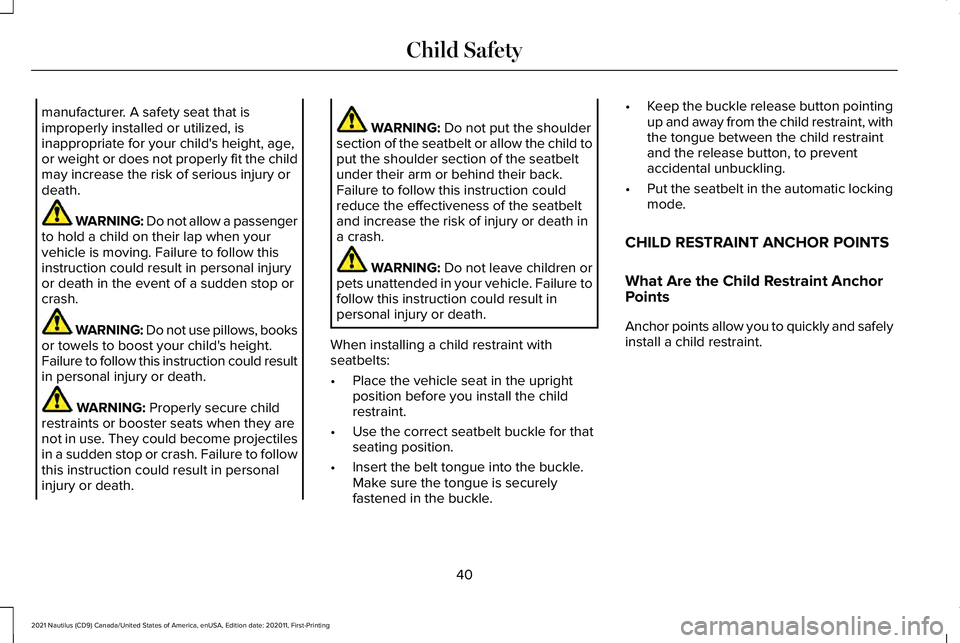
manufacturer. A safety seat that is
improperly installed or utilized, is
inappropriate for your child's height, age,
or weight or does not properly fit the child
may increase the risk of serious injury or
death.
WARNING: Do not allow a passenger
to hold a child on their lap when your
vehicle is moving. Failure to follow this
instruction could result in personal injury
or death in the event of a sudden stop or
crash. WARNING: Do not use pillows, books
or towels to boost your child's height.
Failure to follow this instruction could result
in personal injury or death. WARNING: Properly secure child
restraints or booster seats when they are
not in use. They could become projectiles
in a sudden stop or crash. Failure to follow
this instruction could result in personal
injury or death. WARNING:
Do not put the shoulder
section of the seatbelt or allow the child to
put the shoulder section of the seatbelt
under their arm or behind their back.
Failure to follow this instruction could
reduce the effectiveness of the seatbelt
and increase the risk of injury or death in
a crash. WARNING:
Do not leave children or
pets unattended in your vehicle. Failure to
follow this instruction could result in
personal injury or death.
When installing a child restraint with
seatbelts:
• Place the vehicle seat in the upright
position before you install the child
restraint.
• Use the correct seatbelt buckle for that
seating position.
• Insert the belt tongue into the buckle.
Make sure the tongue is securely
fastened in the buckle. •
Keep the buckle release button pointing
up and away from the child restraint, with
the tongue between the child restraint
and the release button, to prevent
accidental unbuckling.
• Put the seatbelt in the automatic locking
mode.
CHILD RESTRAINT ANCHOR POINTS
What Are the Child Restraint Anchor
Points
Anchor points allow you to quickly and safely
install a child restraint.
40
2021 Nautilus (CD9) Canada/United States of America, enUSA, Edition date: 202011, First-Printing Child Safety
Page 46 of 579
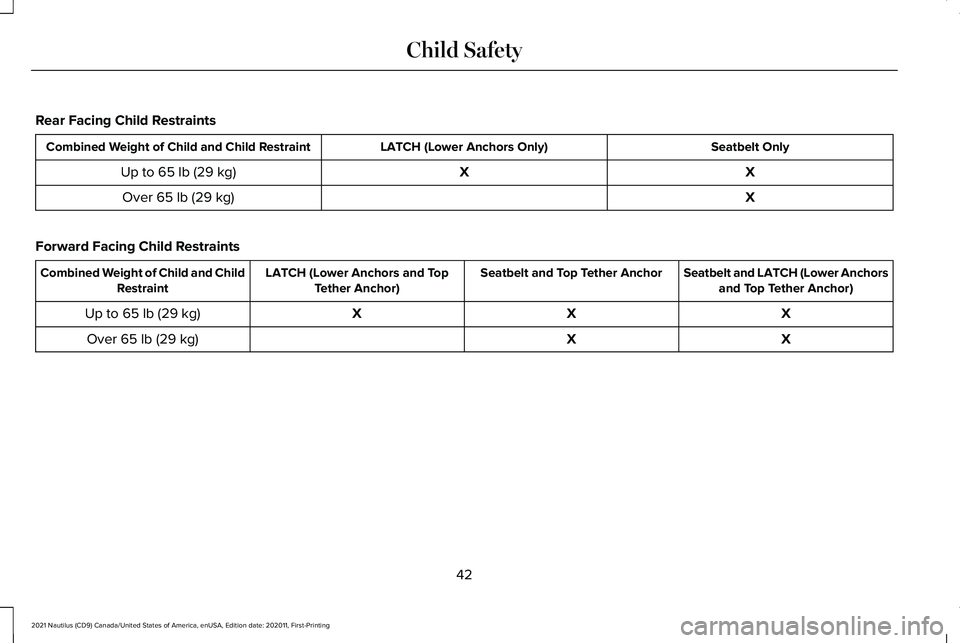
Rear Facing Child Restraints
Seatbelt Only
LATCH (Lower Anchors Only)
Combined Weight of Child and Child Restraint
X
X
Up to 65 lb (29 kg)
X
Over
65 lb (29 kg)
Forward Facing Child Restraints Seatbelt and LATCH (Lower Anchors
and Top Tether Anchor)
Seatbelt and Top Tether Anchor
LATCH (Lower Anchors and Top
Tether Anchor)
Combined Weight of Child and Child
Restraint
X
X
X
Up to
65 lb (29 kg)
X
X
Over
65 lb (29 kg)
42
2021 Nautilus (CD9) Canada/United States of America, enUSA, Edition date: 202011, First-Printing Child Safety
Page 47 of 579
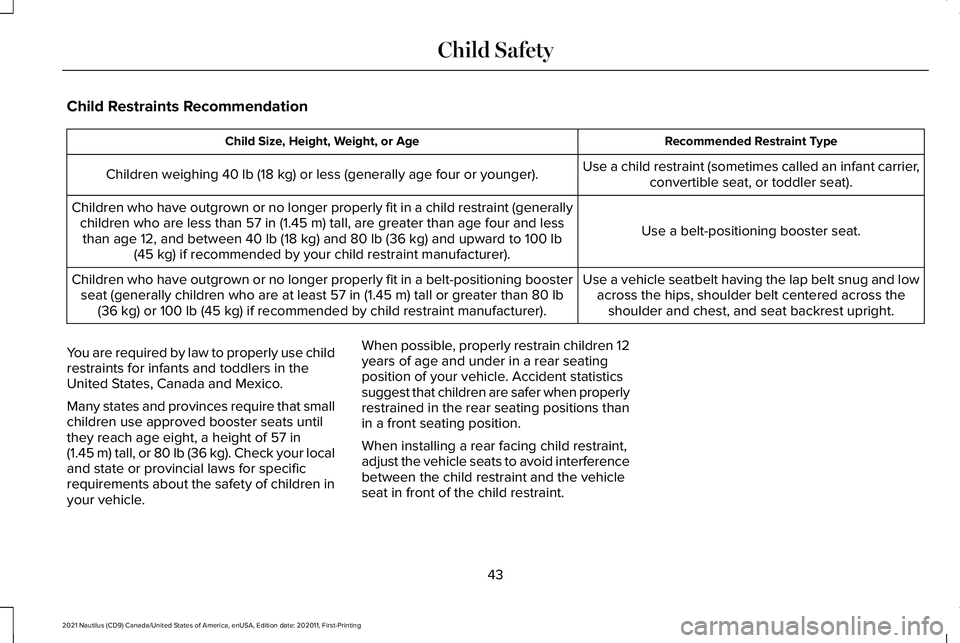
Child Restraints Recommendation
Recommended Restraint Type
Child Size, Height, Weight, or Age
Use a child restraint (sometimes called an infant carrier,convertible seat, or toddler seat).
Children weighing 40 lb (18 kg) or less (generally age four or younger).
Use a belt-positioning booster seat.
Children who have outgrown or no longer properly fit in a child restrain\
t (generally
children who are less than
57 in (1.45 m) tall, are greater than age four and less
than age 12, and between 40 lb (18 kg) and 80 lb (36 kg) and upward to 100 lb
(45 kg) if recommended by your child restraint manufacturer).
Use a vehicle seatbelt having the lap belt snug and lowacross the hips, shoulder belt centered across theshoulder and chest, and seat backrest upright.
Children who have outgrown or no longer properly fit in a belt-positioni\
ng booster
seat (generally children who are at least
57 in (1.45 m) tall or greater than 80 lb
(36 kg) or 100 lb (45 kg) if recommended by child restraint manufacturer).
You are required by law to properly use child
restraints for infants and toddlers in the
United States, Canada and Mexico.
Many states and provinces require that small
children use approved booster seats until
they reach age eight, a height of
57 in
(1.45 m) tall, or 80 lb (36 kg). Check your local
and state or provincial laws for specific
requirements about the safety of children in
your vehicle. When possible, properly restrain children 12
years of age and under in a rear seating
position of your vehicle. Accident statistics
suggest that children are safer when properly
restrained in the rear seating positions than
in a front seating position.
When installing a rear facing child restraint,
adjust the vehicle seats to avoid interference
between the child restraint and the vehicle
seat in front of the child restraint.
43
2021 Nautilus (CD9) Canada/United States of America, enUSA, Edition date: 202011, First-Printing Child Safety
Page 49 of 579

4. Insert the belt tongue into the proper
buckle (the buckle closest to the direction
the tongue is coming from) for that
seating position until you hear a snap and
feel the latch engage. Make sure the
tongue is latched securely by pulling on
it. 5. To put the retractor in the automatic
locking mode, grasp the shoulder portion
of the belt and pull downward until you
pull all of the belt out.
Note: The automatic locking mode is
available on the front passenger and rear
seats.
6. Allow the belt to retract to remove slack.
The belt clicks as it retracts to indicate it
is in the automatic locking mode. 7.
Try to pull the belt out of the retractor to
make sure the retractor is in the
automatic locking mode. You should not
be able to pull more belt out. If the
retractor did not lock, unbuckle the belt
and repeat Steps 5 and 6. 8. Remove remaining slack from the belt.
Force the seat down with extra weight,
for example, by pressing down or
kneeling on the child restraint while
pulling up on the shoulder belt in order
to force slack from the belt. This is
necessary to remove the remaining slack
that exists once you add the extra weight
45
2021 Nautilus (CD9) Canada/United States of America, enUSA, Edition date: 202011, First-Printing Child SafetyE142531 E142875 E142533
Page 72 of 579
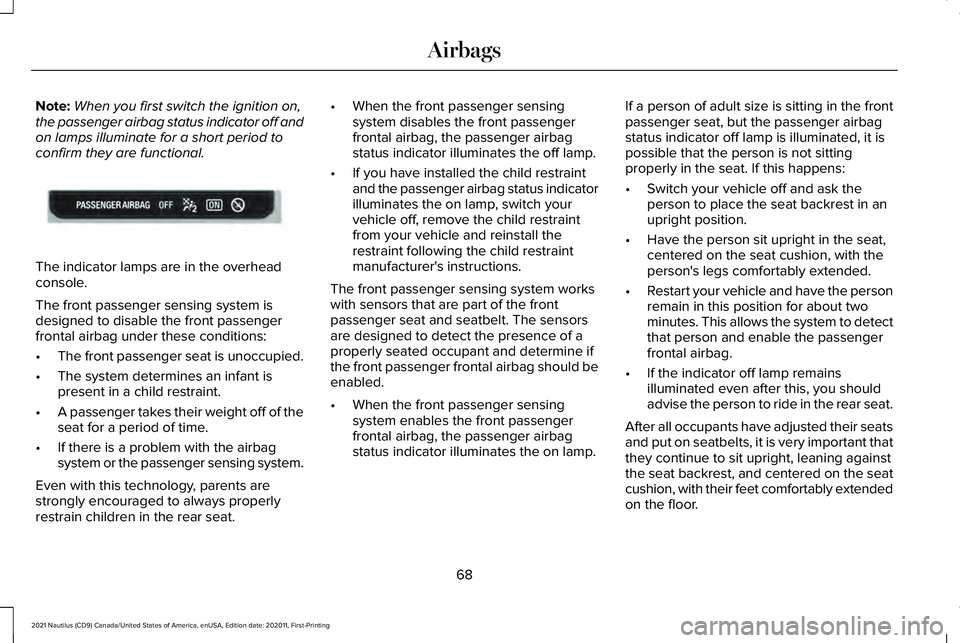
Note:
When you first switch the ignition on,
the passenger airbag status indicator off and
on lamps illuminate for a short period to
confirm they are functional. The indicator lamps are in the overhead
console.
The front passenger sensing system is
designed to disable the front passenger
frontal airbag under these conditions:
•
The front passenger seat is unoccupied.
• The system determines an infant is
present in a child restraint.
• A passenger takes their weight off of the
seat for a period of time.
• If there is a problem with the airbag
system or the passenger sensing system.
Even with this technology, parents are
strongly encouraged to always properly
restrain children in the rear seat. •
When the front passenger sensing
system disables the front passenger
frontal airbag, the passenger airbag
status indicator illuminates the off lamp.
• If you have installed the child restraint
and the passenger airbag status indicator
illuminates the on lamp, switch your
vehicle off, remove the child restraint
from your vehicle and reinstall the
restraint following the child restraint
manufacturer's instructions.
The front passenger sensing system works
with sensors that are part of the front
passenger seat and seatbelt. The sensors
are designed to detect the presence of a
properly seated occupant and determine if
the front passenger frontal airbag should be
enabled.
• When the front passenger sensing
system enables the front passenger
frontal airbag, the passenger airbag
status indicator illuminates the on lamp. If a person of adult size is sitting in the front
passenger seat, but the passenger airbag
status indicator off lamp is illuminated, it is
possible that the person is not sitting
properly in the seat. If this happens:
•
Switch your vehicle off and ask the
person to place the seat backrest in an
upright position.
• Have the person sit upright in the seat,
centered on the seat cushion, with the
person's legs comfortably extended.
• Restart your vehicle and have the person
remain in this position for about two
minutes. This allows the system to detect
that person and enable the passenger
frontal airbag.
• If the indicator off lamp remains
illuminated even after this, you should
advise the person to ride in the rear seat.
After all occupants have adjusted their seats
and put on seatbelts, it is very important that
they continue to sit upright, leaning against
the seat backrest, and centered on the seat
cushion, with their feet comfortably extended
on the floor.
68
2021 Nautilus (CD9) Canada/United States of America, enUSA, Edition date: 202011, First-Printing AirbagsE181984
Page 73 of 579
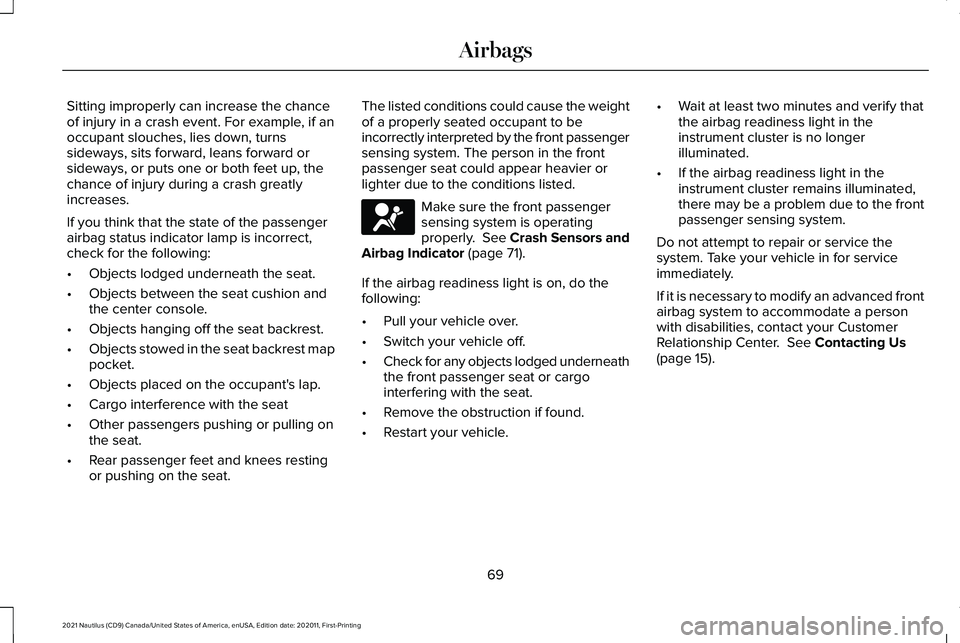
Sitting improperly can increase the chance
of injury in a crash event. For example, if an
occupant slouches, lies down, turns
sideways, sits forward, leans forward or
sideways, or puts one or both feet up, the
chance of injury during a crash greatly
increases.
If you think that the state of the passenger
airbag status indicator lamp is incorrect,
check for the following:
•
Objects lodged underneath the seat.
• Objects between the seat cushion and
the center console.
• Objects hanging off the seat backrest.
• Objects stowed in the seat backrest map
pocket.
• Objects placed on the occupant's lap.
• Cargo interference with the seat
• Other passengers pushing or pulling on
the seat.
• Rear passenger feet and knees resting
or pushing on the seat. The listed conditions could cause the weight
of a properly seated occupant to be
incorrectly interpreted by the front passenger
sensing system. The person in the front
passenger seat could appear heavier or
lighter due to the conditions listed. Make sure the front passenger
sensing system is operating
properly. See Crash Sensors and
Airbag Indicator (page 71).
If the airbag readiness light is on, do the
following:
• Pull your vehicle over.
• Switch your vehicle off.
• Check for any objects lodged underneath
the front passenger seat or cargo
interfering with the seat.
• Remove the obstruction if found.
• Restart your vehicle. •
Wait at least two minutes and verify that
the airbag readiness light in the
instrument cluster is no longer
illuminated.
• If the airbag readiness light in the
instrument cluster remains illuminated,
there may be a problem due to the front
passenger sensing system.
Do not attempt to repair or service the
system. Take your vehicle in for service
immediately.
If it is necessary to modify an advanced front
airbag system to accommodate a person
with disabilities, contact your Customer
Relationship Center.
See Contacting Us
(page 15).
69
2021 Nautilus (CD9) Canada/United States of America, enUSA, Edition date: 202011, First-Printing AirbagsE67017
Page 74 of 579
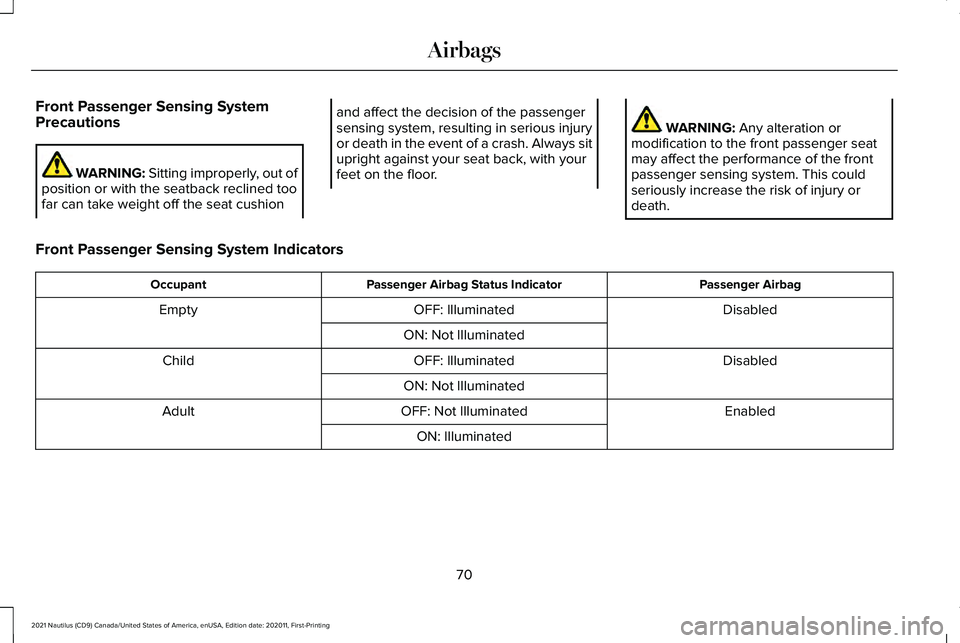
Front Passenger Sensing System
Precautions
WARNING: Sitting improperly, out of
position or with the seatback reclined too
far can take weight off the seat cushion and affect the decision of the passenger
sensing system, resulting in serious injury
or death in the event of a crash. Always sit
upright against your seat back, with your
feet on the floor.
WARNING: Any alteration or
modification to the front passenger seat
may affect the performance of the front
passenger sensing system. This could
seriously increase the risk of injury or
death.
Front Passenger Sensing System Indicators Passenger Airbag
Passenger Airbag Status Indicator
Occupant
Disabled
OFF: Illuminated
Empty
ON: Not Illuminated Disabled
OFF: Illuminated
Child
ON: Not Illuminated Enabled
OFF: Not Illuminated
Adult
ON: Illuminated
70
2021 Nautilus (CD9) Canada/United States of America, enUSA, Edition date: 202011, First-Printing Airbags
Page 111 of 579

Liftgate – Frequently Asked Questions
Why won't my power liftgate function?
Make sure the transmission is in park
(P), ensure nothing is obstructing the
liftgate path and there is not excessive
weight on the liftgate. If there are
continued issues, the battery voltage
may be low or other system issues. See
an authorized dealer.
107
2021 Nautilus (CD9) Canada/United States of America, enUSA, Edition date: 202011, First-Printing Liftgate